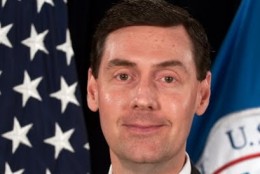Technology
-
The Office of Personnel Management is turning to the Homeland Security Department to help it set the standard for better federal cybersecurity. OPM is still recovery mode as it deals with the consequences of the biggest breach of federal employee data in history. Chris Cummiskey is the CEO of Cummiskey Strategic Solutions, a senior fellow at the Center for Cyber and Homeland Security at George Washington University and former acting undersecretary for management at DHS. He tells In Depth with Francis Rose that says DHS has five big items to tackle before it can — and should — lead the effort.
July 21, 2015 -
A new piece of cybersecurity technology is out from the Homeland Security Department's Science and Technology Directorate. The Network Mapping System tells users what's connected to their networks so they know how to protect them best. It's the third technology out of the S&T Directorate's Transition to Practice program. DHS is licensing the system to Cambridge Global Advisors in Arlington. Michael Pozmantier is in the Transition to Practice office at the DHS Science and Technology Directorate. He tells In Depth with Francis Rose how the system works.
July 21, 2015 -
UPDATED: Agencies with the largest percentage of security clearances, such as DoD, DHS and VA, will end up shouldering a huge part of the burden to pay for the credit monitoring services for 21 million current and former federal employees impacted by the second data breach. AFGE and federal officials are angered after acting OPM Director Beth Cobert tells agencies about OPM’s plans to raise its fees for security clearance services it provides in order to recoup the costs of the identity protection services it must purchase for the victims of the attack.
July 21, 2015 -
The Internet of Things has lots of promise. Program managers and researchers of all types can get a clearer view of what is going on in their world when they can process information from unlimited numbers of data gathering points. But the expansion of network traffic and data from the Internet of Things also carries serious new cybersecurity threats. Chris Eng is the vice president of research at Veracode. He's studied the security implications, and joined Tom Temin on the Federal Drive to review them.
July 21, 2015 -
Brian Marvin, vice president Sales, Public Sector, BMC, joins host John Gilroy to discuss how his company can help agencies achieve their IT goals. July 21, 2015
July 20, 2015 -
The recent false alarm at the Washington Navy Yard has insider threats on the minds of employees at military bases all over the country. The Defense Department has a long list of recommendations to protect itself better against insider threats. The Government Accountability Office issued 79 of them after the Fort Hood shooting in 2009. But DoD doesn't know how it's doing on those recommendations because individual military services aren't consistently communicating and reporting their progress. Joe Kirschbaum is the director of defense capabilities and management issues at the Government Accountability Office. He tells In Depth with Francis Rose about the force protection guidance DoD already has, and the recommendations GAO first made after the Fort Hood shooting.
July 20, 2015 -
Agencies are nearing the end of a 30-day cybersecurity sprint to fix major vulnerabilities in their systems. But every agency can't afford to maintain its own critical infrastructure. Dave McClure is the chief strategist at the Veris Group. John Marshall is founder and CEO of the Shared Services Leadership Coalition. They tell In Depth with Francis Rose that the key to a modern federal cyber strategy starts at the shared services marketplace.
July 20, 2015 -
Four powerful lawmakers want to know whether the Treasury Department will incorporate the Recovery Operations Center's successful big-data tools into its DATA Act initiatives.
July 20, 2015








